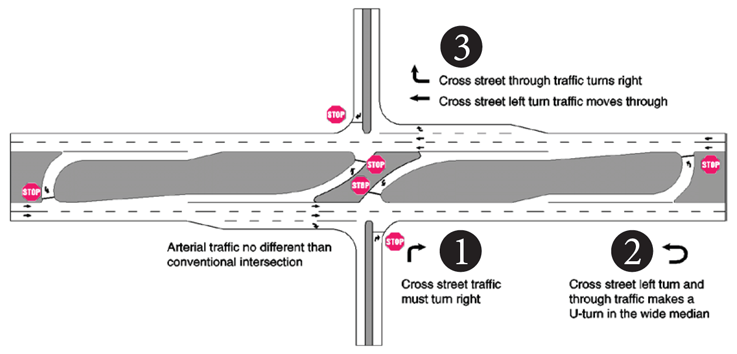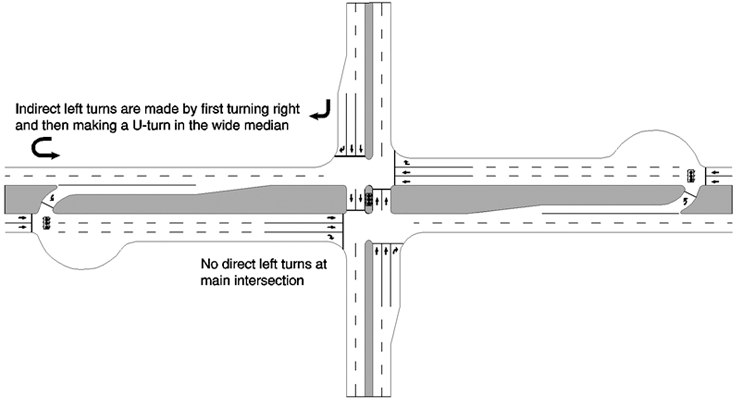U.S. Department of Transportation
Federal Highway Administration
1200 New Jersey Avenue, SE
Washington, DC 20590
202-366-4000
Reduced left-turn conflict intersections are geometric designs that alter how left-turn movements occur. These intersections simplify decision-making for drivers and minimize the potential for higher severity crash types, such as head-on and angle. Two highly effective designs that rely on U-turns to complete certain left-turn movements are known as the Restricted Crossing U-turn (RCUT) and the Median U-turn (MUT).
The RCUT intersection, also known as a J-Turn, Superstreet, or Reduced Conflict Intersection, modifies the direct left-turn and through movements from cross-street approaches. Minor road traffic makes a right turn followed by a U-turn at a designated location—either signalized or unsignalized—to continue in the desired direction. The RCUT is suitable for and adaptable to a wide variety of circumstances, ranging from isolated rural, high-speed locations to urban and suburban high-volume, multimodal corridors. It is a competitive and less costly alternative to constructing an interchange. RCUTs work well when consistently used along a corridor, but also can be used effectively at individual intersections. Studies have shown that installing an RCUT can result in a 30-percent increase in throughput and a 40-percent reduction in network intersection travel time.1

Example of a unsignalized RCUT intersection. Source: FHWA
The MUT intersection modifies direct left turns from the major approaches. Vehicles proceed through the main intersection, make a U-turn a short distance downstream, followed by a right turn at the main intersection. The U-turns can also be used for modifying the cross-street left turns, similar to the RCUT.

Example of a MUT intersection. Source: FHWA
The MUT is an excellent choice for intersections with heavy through traffic and moderate left-turn volumes. Studies have shown a 20- to 50-percent improvement in intersection throughput for various lane configurations as a result of implementing the MUT design. When implemented at multiple intersections along a corridor, the efficient two-phase signal operation of the MUT can reduce delay, improve travel times, and create more crossing opportunities for pedestrians and bicyclists.
Sources
1. Hugher and Jagannathan. Restricted Crossing U-Turn Intersection. FHWA-HRT-09-059, (2009).
2. Edara et al. Evaluation of J-turn Intersection Design Performance in Missouri. MoDOT, (2013).
3. Hummer and Rao. Safety Evaluation of a Signalized Restricted Crossing U-Turn. FHWA-HRT-17-082, (2017).
4. Hummer et al. Superstreet Benefits and Capacities. FHWA/NC/2009-06, NC State University, (2010).
5. Synthesis of the Median U-Turn Treatment, Safety, and Operational Benefits, FHWA-HRT-07-033, (2007).
Filter countermeasures by focus area, crash type, problem identified, and area type.
